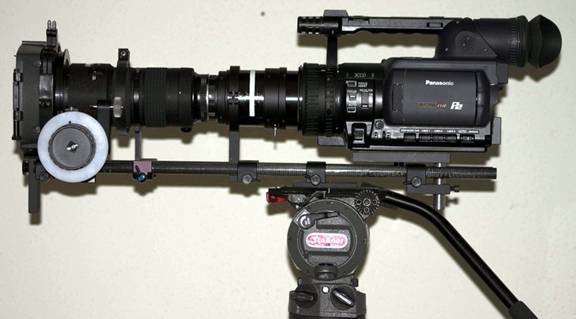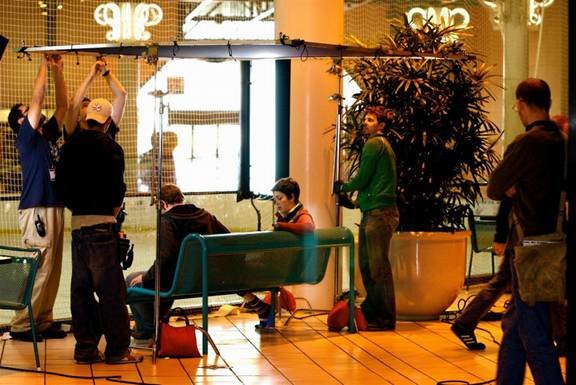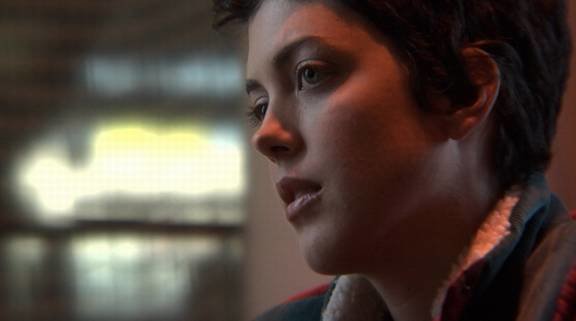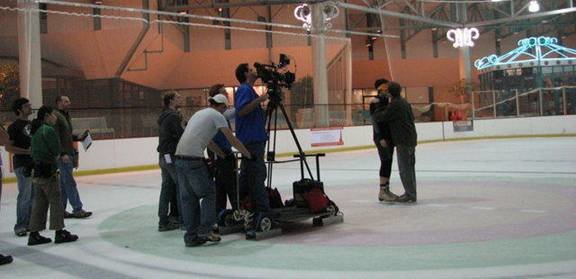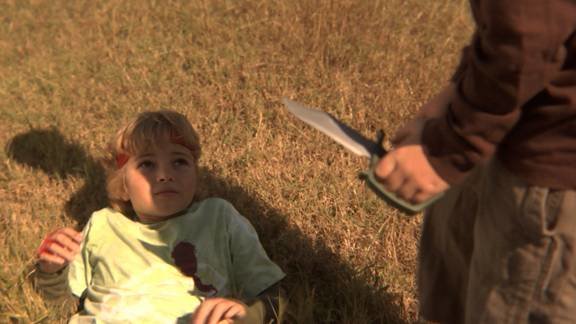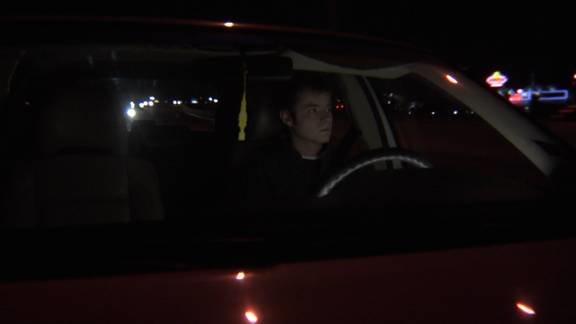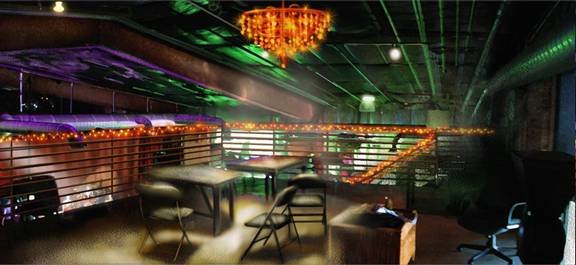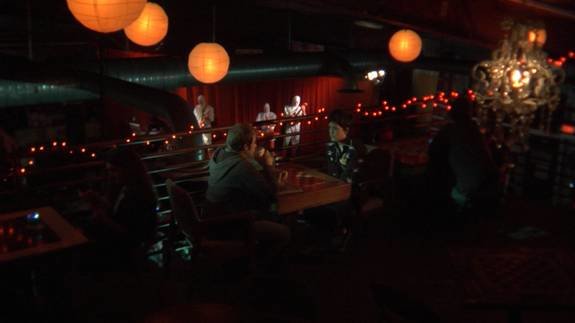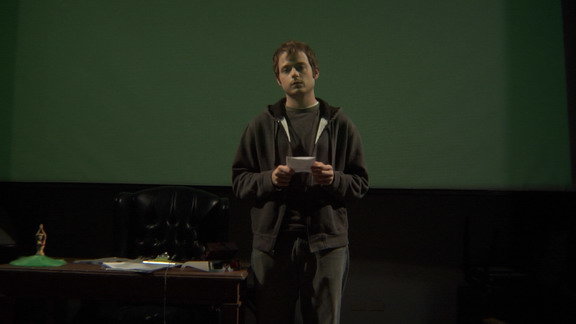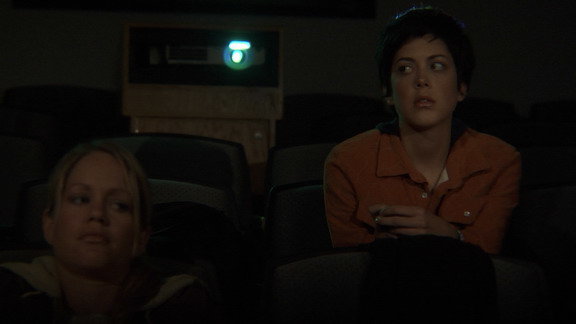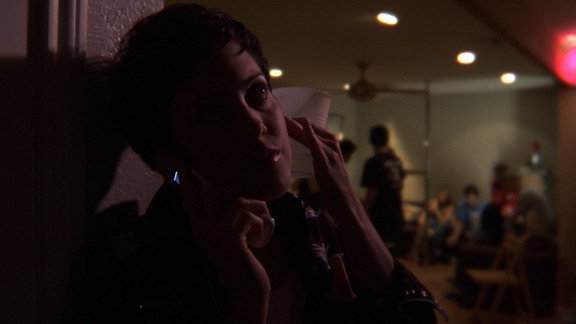
Michael Morlan
Basic Member-
Posts
212 -
Joined
-
Last visited
Everything posted by Michael Morlan
-
Hi all, I tested a couple LED panel instruments recently introduced by Ikan at NAB 2012. Full review at; http://talltalepictures.com/blog/2012/05/23/testing-the-ikan-id1500-ib1500-led-panels/ Here's the summary: I measured color balance, brightness, and beam spread for each instrument. Obviously, I measured both colors for the bi-color instrument. The daylight-balanced ID1500 measured 60 foot-candles (fc) at 10 feet, which is very favorable when compared to the Kino-flo 4ft 4BANK which comes in at 28fc @ 10ft. It has a narrower beam than the Kino, coming in at 45 degrees along its long axis and 30 degrees across the short axis (measured at 5 feet.) I often prefer a more directional source which can be flooded by adding various choices of diffusion. The light displays no noticeable color shift when it is dimmed to 50% – one of the advantages of LED lighting. There is a mild green spike as measured by the RED One camera. The bi-color IB1500 predictably has lower output due to dividing the available LED’s between daylight and tungsten colors. It measured 32fc @ 10ft daylight and 42fc @ 10ft tungsten. Still, that’s better than the comparable Kino 4-BANK. It’s beam spread is slightly smaller than the ID1500, coming in at 30 degrees along the long axis and 25 degrees across the short axis. The daylight side exhibits the same correctable, mild green spike of its cousin but the tungsten side suffers a much more pronounced spike, requiring an aggressive minus-green gel correction to eliminate (at the expense of output.) Both instruments are robustly constructed for use on set with only a couple minor issues to watch out for. More on that in the full review. Best, Michael Morlan
-
a couple 1x1 LED panels compared
Michael Morlan replied to Michael Morlan's topic in Lighting for Film & Video
Excellent addition to the thread, Eric. Agreed on all points. I find I'm willing to use LED sources on non-critical elements; raking a set piece, as a hair light, and, yes, even to light talent in a run-n-gun, realism setting. But, I'd avoid them entirely when lighting for glamor or for rendering subtle details of certain colors and textures. M -
What Phil said. When shooting digital (which, in my world, is almost all the time) I prefer to light by eye and meter - just as I would for film. That is especially important when one is lighting without the benefit of camera, monitor, or scopes on set. But, it never hurts to finalize the image with the best tools possible. So, yeah, learn to use a light meter, learn to light by eye, learn to read waveform monitors, vector scopes, parade scopes, histograms, etc...
-
Hi all, It's been a great while since I've posted so I thought I'd contribute something. A lot of people are enthralled with the new era of LED lighting and, in the lower-end market segment, with the Asian knockoffs of pricey U.S. products. I've scanned a variety of reviews but have not found the kind of data or insight I seek as a DP. So, of course, I did some of my own testing... I tested the Lightpanels 1×1 Superspot and Shantou Nanguang CN-600HS 1×1 panel. My goal with this test was to see how a $350 Chinese knock-off compares to the nearly $2000 U.S. offering and to compare both panels to a tungsten Lowel 250watt Pro-light serving as a reference. 1x1 panels tested Enjoy, Michael
-
Best way to wrap feeder cable?
Michael Morlan replied to Salil Sundresh's topic in Lighting for Film & Video
I have heard various philosophies on the matter: feeder cables - over/under flat on ground stingers 25-50ft - over/under - keeps collective twist out, down side: knots if you pull the end out the wrong side of wrap stingers 25-50ft - over/over - matches the internal winding of the conductors, very fast to wrap, lays out well enough. hmm... The best response I heard to the question about stingers was "If it's yours over/under, if it's a rental, over/over." :-) Also, when running a stinger, start at the power end, drop a loop near the distro box, and pay out cable as you walk towards the load. Drop excess loop near load with end paying out the top. Michael -
Should I join Local 600 at this time?
Michael Morlan replied to Michael Morlan's topic in Business Practices & Producing
Hi Glynn, The great thing about the movie industry is anyone can declare themselves a DP any time. The troublesome thing about the industry is anyone can declare themselves a DP any time... <Ba dum CRASH!> I had been an amateur photographer and professional 3D animator from the 80's to mid 90's. I wrote/directed/shot a couple 16mm projects with borrowed/rented gear and discovered I had a better knack for lighting/framing than storytelling at the time. I spent seven years studying storytelling while shooting other people's projects and started collecting lighting and a JVC GY-DV500 camera. From '97 through '05, while working in the computer game industry, I shot a lot of shorts, increasing my inventory, art, and craft. In '06, I was laid off, yet again, and decided I was done with game development after a decade. I hung out my shingle and, with a well regarded reel, called myself a "DP" for the first time. I have worked on ten feature films - five as DP, and three as gaffer - and my gear still makes more money than me. :) I look forward to the day I walk on set with nothing but meters and a paycheck that pays the bills. :lol: Michael -
Should I join Local 600 at this time?
Michael Morlan replied to Michael Morlan's topic in Business Practices & Producing
The challenge for me is identifying that sweet spot moment to join, as David was describing. That's a bit harder to do in the Texas hinterland (call Texas what you will, it's still just another location for Hollywood) where budgets run shallow and any production with sufficient budget to pay your living expenses comes from the coasts with DP already attached. I'm still examining a couple scenarios as I continue to improve my craft: Work for as many people as possible, waiting for the moment when one of their projects goes the distance (in festivals or distribution) and I get recognized for my contribution. Pursue contacts and projects in L.A. directly by establishing a living base and hanging my freelance shingle there. I think the point between these two approaches is also still in my future. Much more work to do... :) Michael -
Should I join Local 600 at this time?
Michael Morlan replied to Michael Morlan's topic in Business Practices & Producing
Tom and David, Thanks for your excellent feedback. (Mr. Mullen, how do you find the time to answer my question within 45 minutes? Thanks, as always, for everything you give back to the community.) I don't have any union gigs and, as you note David, most features coming to my region hire their DP's out of LA. I need to query some of the DP's in Texas about their union status. It seems the budget at which shoots get organized in LA is quite a bit higher than out in the Texas hinterlands. I'm just trying to get bumped up to the <$1M pics right now. (Last year, I was going to be signed to a $150K feature that got bumped up to $1.2M where I was unceremoniously dropped in favor of a an LA DP. And so it goes.) Methinks now is not the time to join the union. I'll continue doing good work and building my experience and reputation. Many thanks. Michael -
Hello all. Looking for some insight whether to pull the trigger on my application to Local 600 as a DP. I've been invited to join by the reps on the strength of my reel. They have a membership drive going on right now with 50% initiation fees. Everyone wants your money, of course. If I could get some feedback from industry professionals on either side of that line, it would be great. My belief is joining the union will open the door to features beyond the <$200K region I find myself consigned to. (Indeed, a conversation with a regional union rep revealed $225K is the trigger point for organizing a non-union film in Texas.) Some parameters affecting my choice: I live in Texas, a right-to-work state. L.A. could be in my future depending on future opportunities. Texas just passed an effective film incentives bill (that is partially financed and still needs to be fully financed with a separate appropriations bill.) I have 160+ days on set as a DP in the last three years so qualify to work the West Coast. I've worked on six features, three as DP, and numerous shorts, commercials, and music videos. My reel/resume is at michael-morlan.net I own a one-ton G/E package and RED One. While the gear opened a lot of doors for awhile, recently producers and directors have been citing my reel as the deciding factor in hiring me. (Eventually, I would like to walk on set with nothing but my meters on my hip. :rolleyes:) Thoughts? Opinions? Many thanks, Michael
-
Mr. Deakins' website is one of my default browser pages. I was sad to discover he had shut it down for the reason noted by his webmaster: "Thanks to the vindictive and abusive behavior of one individual, we've decided to shut down this site. This was a hard decision for Roger since he has put alot into this site. However, the abuse and the threats were taking away from the goals of the site and it was just too much. In the end, we were just providing an arena for this abusive behavior and who needs to see that?" Mr. Deakins maintained a forum on his site as well as graciously posting some of his notes and lighting diagrams from recent projects. I wrote the webmaster, requesting that Mr. Deakinspublish his wonderful notes and commentary and forgo a forum environment inviting feedback from anonymous, ungrateful wretches. It is a terrible thing when an entire community must suffer for the actions of one. You might consider doing same at rogerdeakins.com Michael
-
Robert, Thank you for that excellent and thorough reply. It was great to read all that in one place. This is a production in Puerto Rico, a territory of the U.S., so I'll check with customs about what import/export documentation I might need. Certainly, the forms you note are necessary for travel elsewhere. Michael
-
Mitch, I believe you should technically be rating the capacity of the battery as 24 amphours, not 24 amps. Regarding the LED 1000, I am suspect of any instrument that claims an equivalent light output to a tungsten source without actually providing luminance charts and ratings. Which tungsten source using which lens system? A 1kW Mole-Richardson Baby fresnel has a different light output (440fc @ 20ft fully spotted 9deg beam angle) than a 1kW Mole-Richardson Mickey open-face (330fc @ 20ft fully spotted 14deg beam angle.) Each instrument's beam spread can also be adjusted where the fixed 30-degree LED solution cannot except with diffusion. When I write about useful luminance charts, I refer to these: Comparison Luminance Charts Definitely do your research. Even better, pull out your meter (or borrow a friend's) and compare. M
-
Hi all, I'm shooting a feature in Puerto Rico and my 1st ac and I will be handling the camera package on the flight from stateside. While I have Fedexed camera packages and other gear, I've not flown with one before. I will have several flight cases with my RED One, lenses, sticks, personal kit, collapsible camera cart, etc. Some questions: Do I check multiple flight cases like normal luggage or go to another location to handle this cargo? How far in advance of the flight do you typically arrive? How can I streamline my experience? Thanks, in advance, for any advice. Michael
-
Hello all, I finally managed to get my reel cut and published. I would sure appreciate any and all crits. Demo Reel I tried something new this time - titles at bottom noting my contribution for each scene. Let me know if those are useful. Let me know if they are distracting or not. Best, Michael Morlan
-
A quest in the debyering/exporting of RED footage
Michael Morlan replied to Evangelos Achillopoulos's topic in Red
Hi Evangelos, Thanks for taking the time to shoot a step test. I'll play around with your .R3D file in the next few days and see what I can discover. I'm still learning a lot myself. Your REDUser thread is quite interesting as well. Besides subjective evaluation of noise in blacks, what other methods would you recommend for ascertaining usable dynamic range? Best, Michael -
Zac, Thanks for a very thorough and thoughtful review of the RED One from your perspective as a 1st A.C. I'd like to add something to your and Mr. Mullen's excellent comments about dynamic range: When shooting digital that has "cine" s-curves applied in camera or planned for post, I have found myself keeping my scene exposures a stop or two away from the ends so the shadows/highlights enjoy a gentle roll-off at the toe/shoulder rather than being rammed hard up against the ends of the resulting digital file's limits. (This is obviously subject to creative and aesthetic choices.) In this case, I could be only using 5-7 stops on the RED One. An alternative, when the control is available, is to use the full range of the camera's linear response then compress the exposure in post before applying the s-curve. This relationship between the ends of the exposure and their location in the s-curve provides a lot of aesthetic choices. As always, test, test, test. Michael
-
I shot on ice for a feature this last November. I specified some ice skates for my doorway dolly that my key grip built for me: ice_skate_attachment_v02_letter.pdf ice_skate_attachment_v02.mov modern_doorway_dolly_v01_with_ice_skate_attachment_v02.mov Some notes: The dolly is only as smooth as the ice surface. We experienced some bumpy rides along the edges of the rink. Consider whether or not to Zamboni the ice surface. Newly surfaced ice is very shiny and very slick. We left the surface frosted over from the previous night so it had a matte surface (good for suppressing hot spots) and good grip for the crew (avoiding the need for spiked shoes (and their inherent noise.) Note, there are special, foam-soled ice shoes you can also equip your crew with. Michael
-
Where can we learn from diagrams?
Michael Morlan replied to Jose Prada's topic in Lighting for Film & Video
Hi Jose, Welcome to cinematography.com. www.digitalcinemasociety.org has a nice set of quicktime videos of an ASC lighting workshop in which four cinematographers each lit a scene in a class setting. They were Michael Negrin, ASC, Alan Daviau, ASC, Robert Primes, ASC, and Michael Goi, ASC. Access to the ASC Lighting workshop is by subscription. (disclaimer: I am not associated with Digital Cinema Society other than being a paying subscriber to their website.) I also have lighting/camera diagrams and set photos accompanying some of the project pages of my portfolio site. If you ask real nicely, I might add a couple more for specific scenes that interest you. :-) Ultimately, however, learning is in the doing. And you can do with very little. Countless times, enterprising young filmmakers have submitted samples of their work lit with nothing but the lights/reflection/diffusion they had at hand. To this day, one of my favorite reflectors is a space blanket crumpled into a little ball then stretched over a piece of foamcore - $11. I've seen many more home-built tools that were truly inspired by the desire to create a pretty picture with whatever was at hand - even if it was just an open window... especially if it was just an open window. Best of luck in your studies. Michael -
Exactly what Robert wrote. Sometimes, when I'm keying, I know exactly where the cut should be and hold the flag while my grip sets the stand. Sometimes, as the D.P., I've talked a grip into position and another member of the team will step up. More often than not, a grip was "hollywooding" a flag and we needed to free him/her up. Just depends on how critical it is and if there is someone handy. I've been told that, in India, labor is so cheap that, rather than placing a light or flag on a stand in a fast-moving set, the keys will merely order up another grip from the available crew. Would that be "bollywooding?" Michael
-
I haven't used the latest of every brand out there. Here's a couple opinions: Matthews: I have eight sliding-leg stands. Their new grip heads are absolutely the best. Set and lock with little to know settling into a final tightness. They have a new design for their sliding legs stands that's very slick. After loosening the wing-nut, I can open/close them with a flick of the wrist. Modern: I have two Gary Coleman (20") stands. Grip heads not as good as Matthews but still a strong, firm grip after they settle into their loads. I don't care for their stainless steel design and slip-on feet. The welds get rusty fairly fast and the feet aren't cemented on. However, the bright yellow foot is a great safety marker on a dark set. Norms: I have some older stands and grip heads so can't comment. I've retired all the boom arms & heads but still use the stands with Matthews hardware on top. Michael
-
What make/model is this FF??
Michael Morlan replied to Michael Morlan's topic in Camera Assistant / DIT & Gear
It's from an eBay auction. According to the seller: "It's a Sammy's conversion. Sammy's was a rental house in Europe that specializes in rentals and manufacturing of after market motion picture equipment." -
-
Anything for Now - prep & week 1
Michael Morlan replied to Michael Morlan's topic in In Production / Behind the Scenes
Hi David. Thanks for your comments. re: steadycam focus - While the Nikons are all geared (done very nicely by Jerry at JBKCine) we didn't have the funds for a remote focus controller so we blocked the scene so Joe, the Steadycam op, stayed within the DoF over most of the shot, with a bit of fudging during sweeping moves. (Joe had recently bought the rig from a retiring operator and hasn't had a chance to buy his own focus motor setup.) On a shot later in the month, I actually reached in and pulled the lens to a new focus as the steadi rig settled to a new mark. I feathered my fingers off the barrel so Joe could gradually regain his balance of the rig with minimal movement of the frame. Certainly not ideal but we made it work. re: the cafe scene lighting - Yeah, I felt it was right at the time. I plays even better in motion. I'm only second guessing myself now. I tried to use some of the elements (line of china ball practicals and banister lighting) to point at the couple as well. Best, Michael -
Prep & Week 1 I?m Michael Morlan, a working D.P. (full time since January 2006) focusing on narrative projects with a smattering of music video, commercial, and industrial projects in my reel. (This series of logs is late in being posted but I?ll leave the use of tense intact from the original writing.) The independent full-length project ?Anything for Now? is an apartment drama with the addition of some nice settings to make a D.P. happy including ice skating rink, underwater fantasy sequence, and conspiracy theorist?s warren. H.R. McDonald is the first-time director and Robin Blesch produces. Shot in Austin and surrounding areas. We?re shooting ATFN on the director?s HVX-200/P2 with Brevis DoF adapter and my Nikon f1.4 AI-S primes and f2.8 AF-D zooms. An interesting thing about the standard ground glass that comes with the Brevis is that it actually adds a stop of light under certain circumstances ? namely WFO to around f4 on the 35mm glass. Even more interesting, the Brevis focusing screen starts to vignette as you close the 35mm iris past f5.6. I suspect this has something to do with acceptance angles between the 35mm lens and the ground glass. HVX-200 camera with Cinevate Brevis (note the focal plane marked with tape) Nikon AF-D f2.8 80-200mm lens, and CAVision follow focus and matte box. I am rating this camera rig, after my creative settings on the camera, at 400asa. I?m asking my gaffer, Iskra Valtcheva for f2.8-4.0 and dialing back the camera?s iris when I want to open the 35mm iris to compress DoF. While we are usually metering during initial lighting setups and when ahead of the camera team, final tweaks are being made by eye and camera monitor ? generally protecting for highlights. I am generally operating but pass that to my 1st A.C., Scott Weatherford, when we are shooting so fast my time is needed lighting the next set. My one-ton tungsten package plus FAY?s, Kinos, doorway dolly w/Modern skateboard wheels, and Porta-jib Traveller round out the kit. Pre-pro Without the budget to hire me full time for a couple weeks preceding principal photography (and because I was on another out-of-town shoot) I contracted to pre-pro on disparate days as needed for location scouting and pre-viz with the director and art director, Marco Noyola. Marco did a bit of conceptualizing the unique settings like the underwater sequence, sterile, white bathroom (our one built set) and club/coffee bar. He has taken the lead on significance of color and I?ve offered my opinions and refinements. Location scouts primarily consisted of the director and my reviewing his camera angles and determining best time of day for each scene. Some property owners have been very accommodating with my request to paint white walls to better suit the mood of some scenes. The director?s thumbnails serve when he has very specific compositions in mind. Day 01 ? ice skating rink We actually shot this scene a few days early because the rink and enclosing mall are close to being demoed and rebuilt. Most of the surrounding store fronts are boarded up and the only real mall customers are retirees enjoying their morning mall walks. We chose to shoot our shorter nighttime scenes before sunrise followed by the day scenes. The space is illuminated by a flat wash of mercury vapor lamps over the rink (with their purplish cast) and sodium vapor cans (yellowish) over the surrounding walkways, which actually creates a nice complimentary palette. scouting shot showing mix of mercury and sodium vapor practicals my crew rigging a double net over the talent Kim (Kristen Malko) in a frame from the HVX-200 I enjoy and employ mixed color lighting and was looking forward to using the practicals for effect. My greater concern was the incredible flatness of the rink lighting ? not unlike sky pans over a white cyc ? very unflattering for an actress. I considered duvatene on the floor and kino?s on our dolly but opted for some creative makeup adjustments to imply shading and a single 4x8 negative fill on the close-ups. Another creative choice we had was whether to have the rink operators Zamboni the ice before we started, resulting in a glossy, slick surface, or to keep the frost accumulated since the previous day. Since I was most concerned with the burn from overheads reflecting in the glossier ice, I recommended we stay with the frost. That more matte surface also resulted in less floor reflection and gave our crew a firm foothold. We set up a shot of our hero?s first kiss. Of note are the doorway dolly ice skate attachments I had key grip, Nick Dearman, weld up for me while I was out of town. With an edge ground up by our kind host at the rink, the skates gave us the freedom to perform smooth and predictable dolly moves on the ice. Interesting to note: An ice skate dolly is only as smooth as the ice itself! We had some issues around the edges of the rink where the ice is most used and abused by skaters. Day 02/03 ? flashback field & car int/ext We start the day in a field dominated by high-tension towers for the flashback of our young protagonist and his best friend. Clear skies on this November day in Texas allow us to keep the lighting simple employing only 4x4 and 12x12 bounces for shadow fill. (In the end, the 12x12 doesn?t play because I have plenty of fill from the sky dome. I opt for a slightly warm white balance to imply the way our protagonist remembers his childhood versus the colder perception of his adult life. (The final sequence of the film, where he has resolved the discrepancy between desire and reality, will also be cast in this similar warmth.) The rest of day two and all of day three are consumed by moving car shots - mostly interior handheld from second seat with some hostess tray and hood rigs. The camera rig is fairly light and I can usually manage to triangulate my hands/arms/knees/legs against some support in the vehicle as we roll. Lacking the time/budget to tow the car on a trailer and light it, we carefully chose sun angles for best effect. An optional white muslin on the actor?s laps fills deeper shadows. Nighttime car interiors are lit by a single home flouro fixture in the dash plus ND to taste. Since we?re shooting WFO at 400asa, it?s fairly easy to get pleasing levels inside the car and still read details in the world outside. A final hood mount on a chase car driven by me and we have some nice exterior freeway driving shots. Day 04 ? film school classroom While we had planned for a stadium style classroom with projector and screen, due to a failure in scouting, we had no idea what our location actually looked like before arriving. But, I?m used to working ad-hoc so wasn?t too worried. Set in the picturesque theater school building at Texas State University (formerly Southwest Texas) we discovered a room well suited to the needs of the scene including; huge projection screen dominating the front of the room, curved stadium seating, and a second-story platform off to the left where our student advisor character has set up a small bedroom and from which he conducts his classes. Upon examining the practicals ? a mix of flouros and par downlights ? I chose two practical pars cross-lighting the ?stage? as our main keys. Two Baby?s plus Lee 251 on hi-hi rollers supported the existing cross-lighting and brought our levels up. Simply rotating them towards seating or stage served most of our turnaround needs. The projector, itself, cast a flat green field on the project and our protagonist. Hair lights on audience member close-ups helped wrap some of that greenish projection around their cheeks. I originally had a Baby through 3x4 soft box pointed at the audience to provide some fill into the nether regions of the seating but that proved unnecessary and I simply let the light fall off on the back rows. A later scene set between classes was lit by one of the practical flouro banks with our Baby?s providing some modeling as needed. Day 05 ? party One of four scenes planned for a steadi-cam, this evening was dedicated entirely to one shot following our heroine as she winds her way through the din the a party to find a quiet place to talk on her phone. Steadi-cam operator, Joseph Kentspeth and I worked with the director to visualize the shot before the crew arrived. We added some background performer crosses to motivate some moves that the director wanted. With that settled, I drew a light plot for my gaffer and two hours later we?re ready to walk through with camera. We approached this shot by first, rehearsing with principals, adding background performers who had movement cues, and then filling in the picture with the rest of our extras. We had to use most of our crew to fill out the crowd (as happens in these low budget projects) but fortunately, since we?re moving pretty fast through the scene, we will be able to use most of them again. Shooting a one-shot scene with its many layered elements all having to time perfectly could be a huge exercise in frustration for this semi-pro team but ten takes later we have it in the can. Every day, I am impressed by the professionalism and passion of my crew and surrounding production staff. Day 06 ? cafe One of the few scenes concepted by our art director, Marco had built a lot of set pieces to serve as focal points and framing elements. Having chosen orange as our heroin?s signature color, Marco includes it as accent on the mannequin band that commands the first-floor stage and in the Chinese lanterns that adorn the ceiling. I add a green as counter-point and edge various elements in the room including railings, corrugated steel walls, and exposed ductwork. Art director, Marco Noyola?s concept for the cafe The camera lived on my Porta-jib traveler this night. I like the freedom a jib provides for instant reframing and small moves. It?s particularly useful when an actor misses a mark and a simple nudge lets me re-frame. More creatively, I enjoy opening up the depth of a scene with a little, controlled movement. Mounting that atop the doorway dolly really lets me cover a room. The café scene as shot Upon review, I wish I had lit our two characters just a bit hotter but, on the set, I felt that was selling it a bit too much. The manniquin band, visible from the first floor, competes for the eye a bit too much. All in all, a very good first week for a low-budget picture. My camera and lighting crews are dedicated and focused and my director knows his story and possesses a light touch. I'm looking forward to the coming weeks. Michael



